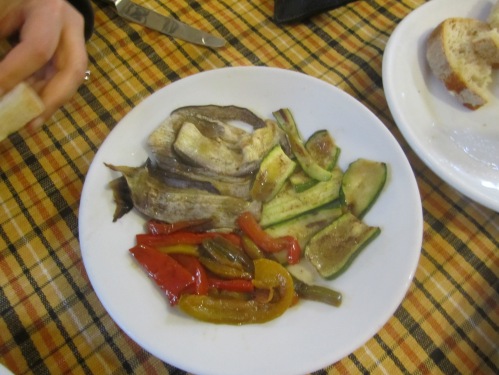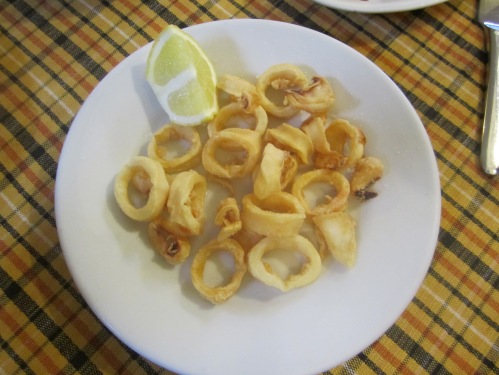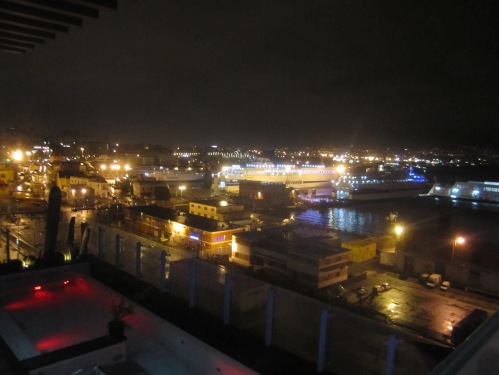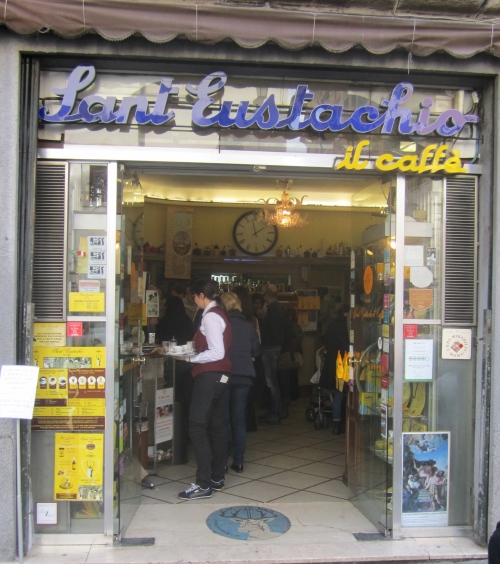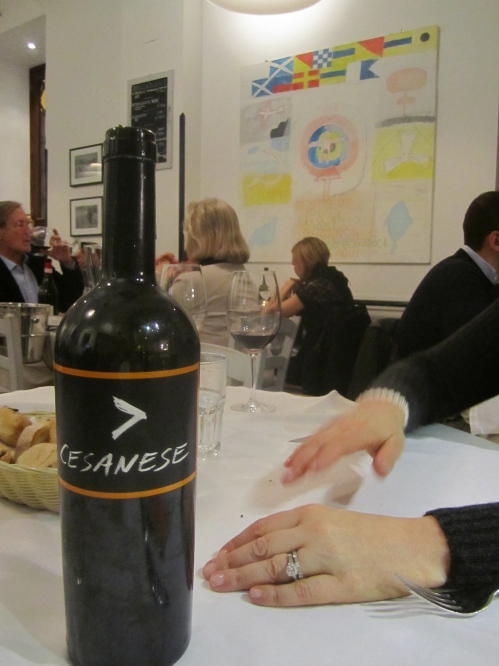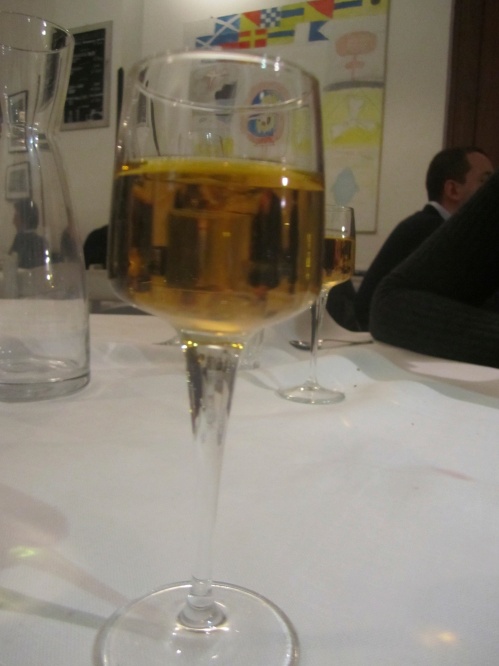Early in my wife Christina’s career she was the Managing Director of The Philadelphia Theater Company and worked alongside then and now Artistic Director Sara Garonzik. We donated a Dinner for Six in our home to their annual auction to support their continued efforts to produce, develop and present “entertaining and imaginative contemporary theater focused on the American experience that ignites the intellect and touches the soul.” (From PTC’s Artistic Mission Statement.) Tonight six folks we have never met are coming to dinner.

It is pleasure for me to cook for others — especially so when I am able to live by what I preach… plan ahead and spread your tasks over time. So two weeks ago after my regular Saturday stroll through the Rittenhouse Square Farmer’s Market, I came up with my initial menu plan. I think of it as seasonal and smart. Seasonal of course. Smart because I want to enjoy my guests as well as cook for my guests. My goal in planning tonight’s menu is to serve a ridiculously elaborate and beautifully seasonal dinner and minimize what I had to do when guests were at the table. I also wanted a menu that allowed me to maximize what I could do well in advance and especially what I had to do the day of the dinner. I was going for not just one relaxed hour before guests arrive — what I believe all hosts deserve, but the better part of a reasonably relaxed and enjoyable day.
Here’s the final menu that I printed for our guests.
The Philadelphia Theater Company
Auction Dinner
Hors d’oeuvres
Squash blossoms stuffed with Hillacres Pride ricotta
Blini with crème fraiche & California hackleback caviar
Grilled Renaissance sausage with garlic scape pesto
Fire-roasted sweet peppers & white anchovy crostini
Jersey tomatoes & fresh chickpeas with crabmeat
Chinon “La Cravantine” Domaine Gasnier
Dinner
Ceviche of Barnegat scallops
Orange essence & pink peppercorns
Z Food Farm pickled beets & chilled ginger-beet soup
Arneis “Bricco delle Ciliegie” Giovanni Almondo 2011
Seared Atlantic tuna taco
Sesame-cucumber relish
Shiso aioli
Nahe Riesling “Lenz” Weingut Emrich-Schönleber 2011
Charcoal-grilled Griggstown Farm quail
Lemongrass & coriander
Green papaya salad
“Becco Rosso” Corte Gardoni 2010
Braised veal cheeks
Ratatouille & corn cake
Morgon “Côte de Puy” Domaine de Robert
Local artisanal cheeses
Birchrun Hills Fat Cat (Chester Springs, PA)
Birchrun Hills Blue (Chester Springs, PA)
De Glae Lanchego (Lancaster, PA)
Valley Sheperd Crontin de Chevre (Long Valley, NJ)
Shellbark Hollow Sharp Chevre (West Chester, PA)
Local honey • Apricot butter • Candied walnuts
Metropolitan Bakery breads
Terres de Fagayra Maury Blanc 2009
Cardamom-poached Three Springs Fruit Farm Peaches
Biddle Woods lavender ice cream
Gooseberries & blackberries
French Press Espresso
Saturday, July 14, 2014
What follows is a kind of home entertaining case study. I am not suggesting that you attempt to replicate this exact menu in your home. I have been doing this professionally and recreationally for more than forty years. But I do suggest that you use this as a model of planning ahead and spreading tasks over time so that you too can have at least one relaxed our before guests arrive.
Early Saturday Morning
It’s about ten hours until guests arrive. All is well. I began planning and preparation two full weeks in advance by planning the menu, scheduling my shopping and food preparation tasks. My very first task was pickling the beets that I bought two weeks ago from my friend, farmer Dave at his Z Food Farm stand in Rittenhouse Square. Z Food Farm is located in Lawrenceville, NJ. On my stroll through the market that Saturday, in addition to pink Chioggia and golden beets, I noted garlic scapes, squash blossoms, zucchini, eggplant, tomatoes, summer squash, early corn, the first apricots of the season, and beautiful scallops and tuna. So, my menu plan began with essentially a list of seasonal, locally-sourced ingredients. Since shopping in a farmer’s market is a pleasure, I looked forward to this morning’s trip to pick-up “day of” ingredients as well as flowers.
Why is it that it’s hot and sunny all week without quenching rain to water thirsty crops and on Saturday when farmers have a single day to sell the fruit and vegetables of their labors, it rains? Why in the wealthiest country in the history of civilization do 43 million people not have health insurance? These and other questions about life will be left to ponder. (Actually for more on the one about health insurance see the postscript at the end of this post.)
Suffice it to say that the best laid plans of spontaneity cooking oft go astray. No golden raspberries so I switch to blackberries. Renaissance Sausage’s stand re-emerged after a few weeks absence with no fennel-pork sausage. But the tuna is gorgeous, the scallops plump and the flowers spectacular.

Dave’s first crop of exotic cucumbers appeared today even though Dave did not. Dave left the stand to his mom and dad as he tended a fresh crop of field volunteers. That’s Dave’s stand and his mom and dad.
Late Saturday Morning
There are now about eight hours to guests. My primary tasks are to do the things I could not do days ahead — prepare the corn cakes, the cucumber relish, the squash blossoms, slice the scallops and the various herb leaves I plan to use to garnish courses. I also make a few made a few minor revisions to the menu.
The first order of business was doing the flowers. I have been arranging flowers since 1972 when I was a busboy at La Panetiere. The late proprietor Peter von Starck, who prior to my arrival did all of La Panetiere’s arrangements, gradually taught me the art of flower arranging and so began my love affair with flowers.

Soaking wet from the Saturday down-pour, I arrived home armed — literally — with flowers. The Rittenhouse Square Farmer’s Market includes two flower stands including one with farm fresh flowers from an Amish farm in Lancaster.
We were given a wonderful wedding gift some years ago — about twenty-four narrow tubes, flexibly joined together a bit like a snake so that you can shape your arrangement many different ways. The tubes hold the flower stems erect and make for very easy arranging. We were using a round table for our dinner instead of our standard rectangular dining room table. A round arrangement was in order — low so people could easily see and talk over it. Since Christina wanted candles on the table, first I tried placing the candle holders and candles in the hollow center. But I didn’t want the candles too high either. The right height candles were too low to work in the center. That’s when I had the bright idea of putting votive candles in the hollow center so that they would candlelight would shine through the glass tubes. This worked to magnificent affect.

Sometimes flower arrangements are meant to be looked at from only one direction so you can make the arrangement looking at it from that direction. But often arrangements are meant to be looked at from all around including the centerpiece for our table. Here was my second bright idea. As long as I have been arranging flowers, it never occurred to me place the evolving arrangement on to a revolving platform. There are cake decorating stands that rotate. Our bakers use them all the time to decorate cakes in the round. In preparation of making as much empty counter space as possible for dinner turn-out, I had done some re-arranging. This resulted in an empty Lazy Susan sitting on the counter. Suddenly it occurred to me to pick-up my vase and plop it on the the Lazy Susan. Viola!
So at the tender age of 65+ and feeling like a reasonably smart fellow, I discover that I’m not so smart after all. For how many years have I been walking around my flower arrangements to get an all around view or carefully turning the vase occasionally to get a different vantage point? Now, with my arrangement smartly placed on my Lazy Susan, a simple spin enabled me to simply and constantly look at my developing arrangement in the round. I assume “real florists.” like real bakers have been doing this for years. Who knew?

The finished arrangement placed on the set table.

Here are a collection of arrangements I made for the dining room breakfront, the coffee table and the bathroom. In total the flowers cost just under $50 and I thoroughly enjoyed making the arrangements.
Friday Evening
Entertaining at home is a team sport and Christina and I make-up the team. She handles, in restaurant parlance, the “front of the house” while I handle the back of the house…aka, the kitchen. Early in the week Christina began “de-cluttering” as she calls it. A ‘de-cluttered’ apartment turns out to be a residual benifit of home entertaining. People who are familiar with my At Home blog and book — At Home by Steve Poses: A Caterer’s Guide to Cooking & Entertaining — know that I utilize repositionable address labels for organizing my tasks. This is something I developed many years ago for Frog Commissary Catering. So when time comes for Christina to get to work, I give her a sheet of these labels on which I have indicated everything that we will need for each course. She uses these to pull what we need and the label gets affixed. So, for instance, we needed a platter for the crostini hors d’oeuvres. Christina knows that from the label. She picks the platter and places it in the kitchen with its label so I know what it’s for. Organization is the foundation of enjoyable home entertaining and the more organized the hosts, the more enjoyable it is for both hosts and guests.
By Friday evening the table was set and plates, flatware and glassware organized for our six-course dinner.
Friday Afternoon
Shopping is certainly a big part of home entertaining, but if you don’t feel rushed, shopping can be a pleasure and not a chore. My Friday afternoon shopping objectives included picking up the wine from Moore Brothers, trying to track down a better small container for the first course’s cold gingered-beet soup than the ceramic sake cups that we had, buying the green papaya at my favorite Asian market and the fresh-made corn tortillas from Tortilleria San Roman.
Earlier in the week I had emailed the menu to Greg Moore – a Moore brother — with the request to pick a sparkling wine for cocktails and pair wines for dinner. I gave Greg a budget range of no more that $20-$25 a bottle. An email a few days later included Greg’s recommendations. While I knew of none of the wines, I knew that Greg and Moore Brothers have a deep knowledge of the wines they carefully select for their stores.
I had looked online for small glasses with a base that would fit into the cut-out in the little plate I planned to use for the first course. It was there that I discovered Gourmet of Old City right here at 26 North 3rd Street in Philadelphia. The shop had exactly what I needed — a clear glass sake cup with a small foot.

After swinging by San Roman at 9th & Carpenter to get the best of Philly (at least I think so) fresh corn tortillas, it was off to Hung Vuong Asian Market on the 1100 block of Washington Avenue. It is in the same shopping center as our favorite Vietnamese restaurant — Nam Phuong. (My second date with Christina some seven years ago was dinner at Nam Phuong and a tour of Hung Voung! Tres romatic.) Hung Voung carries the green papaya I needed for the green papaya slaw that would accompany the quail and they have it and carrots pre-shredded that makes preparing this salad a snap. I shop at Hung Voung regularly and a week earlier I picked up kaffir lime leaves and lemongrass that I needed for marinating the quail. (Restaurant alert: The grilled quail that I planned to serve was inspired by the roasted quail that Nam Phuong serves.)
Friday Morning
My stroll through the farmer’s market nearly two weeks ago inspired me to serve ratatouille with the veal cheeks. Last Saturday I purchased the requisite ingredients — zucchini, summer squash, eggplant, tomatoes (I decided to use little orange Sungolds), onion and garlic. They sat quietly in my refrigerator. I didn’t want to make the ratatouille too far in advance, but Friday morning seemed perfectly fine.
I also removed the quail from the marinade and carefully scraped off the kaffir lime leaves and lemongrass. I dried the quail and stored them between paper towels to remove any residual moisture.
Thursday Afternoon
I had a long-scheduled meeting at Reading Terminal Market on Thursday afternoon so I knew that I could pick-up cheeses from the Fair Food Farm Stand’s. Fair Food is a pioneer in championing the growing bounty of locally-sourced farm products. The prior Sunday I had picked up at the Head House Farmer’s Market a Fat Cat from Birchrun Hills. That was a start, but I had my eye on a selection of five cheese. If you have not yet discovered the world-class quality of local cheeses, Fair Food is the place to start as well as at farmer’s markets throughout the Delaware Valley.
Thursday morning
I skimmed off the fat from the veal cheek braising liquid and reduced the liquid by about two thirds until it was very concentrated. Yum.
Wednesday
I trimmed the quail and marinated them. I removed the braised veal cheeks from their braising liquid and strained the liquid and refrigerated.
Tuesday
I chopped the kaffir lime leaves and lemongrass for the quail and made the marinade. I made the dressing – essentially the same as the marinade — for the green papaya salad.

I removed the veal cheeks from their white wine marinade, patted them dry, lightly floured and carefully browned. I divided the cheeks between two pans over a layer of chopped carrots, celery and onion, peeled garlic cloves and parsley, rosemary and thyme. I added the wine marinade and some additional wine. Next I covered the pans with foil, poked some holes in the foil so the cheeks would braise and not steam and placed in a 250 degree oven. When finished six hours later, the cheeks had shrunk to a little more than half their former size and plumped up. After they cooled in the braising liquid, I transferred the cheeks to a smaller refrigerator-friendly container and strained the braising liquid and refrigerated.
Monday
I chopped the kaffir lime leaves and lemongraas for the quail, made the gingered-beet soup, roasted. peeled, julienned and marinated the sweet peppers for the crostini, chopped the onions, carrot and celery and peeled the garlic for braising the veal cheeks.
The Prior Weekend
I bought the peaches several days ago so that they could ripen. By Saturday weekend they were ripe. I peeled the peaches. As these were the first crop of summer peaches, they are what are called “cling” meaning that the peach flesh clings to the pit. Later in the summer “freestones” arrive. Because these were cling peaches, I had to take particular care freeing them from their pits without bruising by cutting small wedges and nudging them. Once freed from the pits the peaches were poached in a cardamom-infused syrup. I removed the peaches when they were not quite done as they would continue to cook and I did not want them to become too soft. Once the peaches and liquid had cooled combined and refrigerated.
Sunday began with a trip to the Head House Farmer’s Market where I purchased frozen Griggstown quail. I would have preferred fresh, but practicality took hold as fresh would have required a two plus hour round trip to the Griggstown Farm above Princeton. I picked up the fresh ricotta from Hillacres Pride and found shiso leaves.
The Week Before
Of the six dinner courses, only two curses were hot and only one required actual last-minute cooking. The other could be prepared entirely in advance and just reheated. Before planning the menu I had checked with our dinner guests as to whether there were any food issues. Veal cheeks fit the in advance bill. I first prepared braised veal cheeks some three and a half years ago when I was working on the menu for Christina’s and my wedding at The Franklin Institute.
Unfortunately it is not easy to find veal cheeks. Calling around, I located them at Esposito’s on 9th Street — across from San Roman on Carpenter. Though veal checks are small, I needed only one per person as all the courses in the multi-course meal were meant to be small. The problem is that Esposito’s only sold veal cheeks by the 10-pound case — about 32 veal cheeks for $129. I was mentally committed so I purchased the case, reasoning that I would braise them all and freeze what I did not need for another time.
Preparing veal cheeks is a simple process. The most difficult part is trimming away the “silver skin” that covers the entire of the top side and some of bottom. It takes a very sharp knife, patience and about an hour. with that accomplished, I rubbed the cheeks with a mixture of toasted crushed fennel and coriander seed and let it sit for two days. Next I added a white Rhone — a viognier — and let them sit another two days. Veal cheeks are typically marinated and braised in red wine. But I wanted a light summer version. At this point I had been “working on” my veal cheeks for four days, but only about an hour and a half.
One Relaxed Hour
I enjoyed my Saturday. Inevitably there was more to do than I had anticipated but at no point did I feel hassled, out of control and resentful — all feelings that I have known when I have entertained at home without adequate planning and spreading tasks over time. Paul, our wonderful Frog Commissary waiter had arrived. Christina went over the plan for the evening, the wines and I reviewed the menu and the plating plan. By 5:30 I was taking a nap.
A Half Hour Before Guests Arrive
About a half hour before guests arrived I arranged the cold hors d’oeuvre platters, pulled things from the refrigerator, reviewed my course labels and set the charcoal in the grill. Christina appeared in the kitchen with a glass of sparkling wine to get the evening started. Shortly after seven the guests arrived. Christina and I were looking forward to an enjoyable evening.
Hors d’oeuvres and Cocktails
I have two principal dictums for guests. One is do not arrive early. Despite my pleas to plan ahead and spread tasks over time, there are still last minute things for hosts to do so one thing they don’t need to do is to begin entertaining you before the appointed hour. My second dictum is for guests to stay out of the kitchen unless invited.

Our evening began in our living room with the coffee table was invitingly set with champagne glasses, small plates, cocktail napkins and a few cold hors d’oeuvres. As guests arrived we poured the Chinon La Cravantine Vignoble Gasnier Non-vintage, a sparkling French wine (it was Bastille Day) from the Loire with a slightly pink cast. (Note: The two red velvet covered chairs in the photo background come from the Orchestra Boxes of the Academy of Music — a fundraising benefit in return for a contribution Christina made to the Academy some time ago.)

Roasted sweet peppers, marinated in olive oil and garlic on top of a small crostini cut from a ficelle (essentially a small baguette) and topped with white anchovies. White anchovies are available in specialty food stores such as DiBruno’s and online. A little sprinkle of fresh chopped parsley added some color.

Squash blossoms are a beautiful and edible by-product of growing zucchini and other summer squash. Here they are stuffed with a mix of Hillacres Pride ricotta that I picked up at the Head House Farmers Market and mascarpone with some chopped basil, mint, salt and pepper. I used a pastry bag to stuff the flowers.

Last Sunday at Head House I bought a pint of fresh chickpeas. These have a very short local season. I didn’t know what I was going to do with them and they just sat in my refrigerator. I was uninspired. As the dinner approached it was now or never. I blanched the chickpeas and removed them from their pods. This is a slow and tedious process and Jon Stewart and Stephen Colbert help get this done. I peeled two ripe red tomatoes, seeded and removed the juice and diced. I threw a little olive oil and garlic into a pan, lightly browned the garlic, added the chickpeas and Allepo pepper, cooking until the tomatoes broke down and thickened. I served this cold with a little fresh crab meat and some cooked tomato on top. It sits on a platter on a bed of dried beans to stabilize the little porcelain spoons.

This hors d’oeuvres’s origin was my love of the early summer arrival of garlic scapes — the long green shoots that emanate from hardneck Rocombole garlic. Garlic scapes appear for about a month beginning in late Spring. Usually I just grill them – sometimes blanching first. But garlic scapes also lend themselves to garlic scape pesto. Ah, but what to put the pesto on? I am a big fan of our local Renaissance Sausage. I was first introduced to them when they operated a truck at Head House where their Breakfast Sausage Sandwich was a Sunday highlight for scores of Society Hill and Queen Village shoppers. I had trouble tracking down the sausage — only able to find vegetarian sausage at Green Aisle Grocery in South Philadelphia. They often have a retail stand in the Rittenhouse Square Farmers Market but they had been AWOL for the past several weeks. I sent an email to them and learned that they would indeed return on Saturday as they did. But they had no Italian style pork sausage. I had to settle for their Country Pork Sausage, laden with herbs that were going to compete with my basil-infused garlic scape pesto. Not ideal, but good enough.

Caviar is always a treat. Here I serve it on blini that I had in the freezer — leftover from a Frog Commissary catered event and creme fraiche. The caviar is a California Hackelback — the best barely affordable domestic caviar. With mostly cold hors d’oeuvres, my kitchen time was kept to a minimum. We also had Paul, a wonderful Frog Commissary waiter to help with service. I fully understand that you likely will not have a waiter for your dinner for eight, but the principles of do ahead and lots of room temperature items stand. Having a waiter enabled Christina to hold down the fort with our guests while I was in the kitchen. If were were serving dinner to friends and family Christina would be more able to help serve as would friends and family!
Dinner is served
Shortly before calling guests to dinner I retreated to the kitchen where the elements of each course — what is called mis en place in kitchen parlance — were carefully arranged on an otherwise clear counter. Affixed to the cabinet above the mis en place was a little label that reminded me what went with what. My experience is that the more I have written down the less I have to remember and the more likely I am do what I planned. (My otherwise marvelously capable late mother was known to find the salad she had prepared for guests still in the refrigerator long after the last guest departed. I am sure had she written down “serve salad she would have avoided this sad outcome.) I started the fire in the little Japanese grill that sits on our fire escape so the charcoal would be ready to grill the quail about an hour into the dinner. I removed the quail from the refrigerator. I dressed the green papaya salad. Removed the cheese from the refrigerator to temper. Placed the veal cheeks and ratatouille in a 300 degree oven to slowly warm. I quickly seared and sliced the tuna for the taco.

Our first course — preset and on the table as guests sat — was inspired by a recent trip to Berlin where at a restaurant named Bandol we had a wonderful dinner and encountered the plate pictured above. (Not that exact plate!) It is hard to understand scale in the photo. The plate, which looks like slate but is actually porcelain, is only slightly bigger than a 3 x 5 card. Upon returning home I tracked them down online at Chef’s Arsenal and ordered ten. This was my first chance to use them. The course included little wedges of pickled — the predominant pickling flavor being star anise – thin-sliced pristine sea scallops that sat for a few hours in fresh orange juice. I dressed the scallops with a little lime juice, a drizzle of peppery olive oil, fresh chives, a crunchy pink sea salt and a few pink peppercorns. The soup was a gingered red beet puree with a tiny chive blossom. All pretty as a picture.
Our wine was a 2011 Roero Arneis “Bricco delle Ciliegie” Giovanni Almonde. From the Piedmont area of Italy, it paired perfectly with the little study in beets and scallops.

I have come to love little tacos. This one was inspired by the shiso leaves that I found at Head House last Sunday. The taco is cut to about a 3 3/4″ size with a circle cutter and lightly warmed in a dry pan to soften. Next a large shiso leaf. Next a relish of two types of cucumbers from Z Food Farm dressed with rice vinegar, a little olive oil and soy sauce. On top of that was the Atlantic tuna that had been cut into 3/4″ square logs and very quickly seared, sliced and arranged on a platter into eight portions. The tuna was topped with a shiso aioli — essentially a garlicky mayonnaise with lots of crushed shiso leaves and finally topped with a chiffonade of and a sprinkle of toasted sesame seeds. I know this sounds fabulously complicated but everything was prepared ahead and it took maybe two minutes to assemble these on to waiting plates.
Greg Moore suggested a Nahe Riesling “Lenz” Weingut Emrich-Schönleber 2011. In Germany we came to appreciate Reislings and loved that Greg introduced one for our dinner.

On to the Griggstown Farm quail. As noted above, these had been marinated for two days in a marinade of chopped kaffir lime leaves and lemongrass, rice vinegar, palm sugar, fish sauce and a little chili garlic sauce. The green papaya slaw was dressed and ready to go. I just had to grill the quail which took about three minutes. I brush the quail with a little olive oil. In grilling I had to be careful with the quail because the sugar from the marinade which helps color the skin when it caramelizes over the coals, can easily go too far and burn. The cilantro leaves had been picked during the afternoon. To assemble a small mound of green papaya slaw went down on the plate, topped with some crushed peanuts, then the quail and a few cilantro leaves. One hot item and a simple plate.
For the quail Greg suggested a Bardolino, a light fowl-friendly Italian red — “Becco Rosso” Corte Gardoni 2010

Here are the veal cheeks, set on a small bed of ratatouille with a little corn cake. When I served the quail I had popped the corn cakes into a 350 degree toaster oven. The veal cheeks and ratatouille were hot and sitting happily in a 200 degree oven. I had a very concentrated reduction of the braising liquid that went into the microwave for a minute just before serving. I small spoon of that glazed the veal cheeks just before serving. A few flat leaf parsley leaves — pre-picked from their stems and stored between two damp layers of paper towel — added a touch of color. The veal cheeks were meltingly soft and carried the flavor of the coriander and fennel seed rub beautifully. The plate was 12″ in diameter and had a little “belly” for the food to sit. Nice.
In keeping with the light preparation of the veal cheeks, we served a light French cru Beaujolais — Morgon “Côte de Puy” Domaine de Robert. Perfect.

Our guests loved the cheeses, all produced within fifty miles of where we were sitting. Accompanying the cheeses were Metropolitan Bakery breads, lightly toasted, candied walnuts, a few flatbreads from DiBruno’s and a wonderful apricot butter that I made from local apricots.
For a wine Greg bypassed the obvious third red in favor or a light fortified white that he suggested would work wonderfully for both the cheese and dessert course. Of course, he was right. The wine was a Terres de Fagayra Maury Blanc 2009 from the Languedoc region of southern France. It was uncanny how Greg seemed to channel the menu and select really delightful and interesting wines, perfectly complimenting the food and adding immeasurably to our dining experience.

On our very first date I made lavender ice cream for Christina and it’s always been a favorite of hers. Dessert on a triangular plate included the cardamom-poached peaches, just-picked fat and juicy blackberries from Beechwood Orchards, a gooseberry split in half and, of course, the lavender ice cream. To add a touch of chocolate, I picked up Saturday from DiBruno’s chocolate-covered figs — an unnecessary addition, but what the heck!
The Party’s Over

We certainly had lots of food and wine, but the portions were all quite small and the dinner itself paced over about three plus hours. And here’s the very best part. Having six people to your home (three couples) who you have never met is like a blind date in which you skip the part about having coffee first and go straight to a long evening with no graceful exit if the chemistry isn’t right. Well, the chemistry was as good as the food and wine. Our guests were warm, interesting and engaged. When all was said and done, six strangers who came to our home for dinner in support of a good cause left as our friends.
Election Postscript
I am devoting much of my time between now and November 6th to the Obama Campaign. I am what is called an Obama Fellow — a nice title for “very serious volunteer.” I have some time and made the decision that when I wake up on November 7th I want to feel as though I did all that I could to re-elect President Obama. While I do not agree with everything he has done, I believe the choice is simple and binary — Barack Obama or Mitt Romney. Obama needs 270 electoral votes to be re-elected. Pennsylvania is one of a dozen critical battleground states that will determine the outcome of the election. With 20 votes, Pennsylvania has more electoral votes than any of the battleground states other than Florida which has 29. It is difficult to see a path to winning for Obama without winning Pennsylvania.
My focus is the area of Philadelphia called Center City West — where I have lived and worked for more than forty years. I know many blog readers live in Center City West and/or know people who do. The campaign needs volunteers. If you are interested in volunteering in Center City West or know of others, you can email me at steve@athomebysteveposes.com. Otherwise, go to barackobama.com.
 Note: In March Christina and I spent about two weeks in Rome and Naples. A principal reason for our trip was the impending opening of the One Day in Pompeii exhibit at The Franklin Institute where we provide food services. Ours was a journey to understand the culinary context of Pompeii today and be able to present that at The Franklin Institute during the run of the exhibit. Pompeii is located in Italy’s Campania region. It sits at the base of Mt. Vesuvius, across the bay from Naples. One Day in Pompeii opens today, November 9th and will run through April 27th. I began this series of posts in Rome and there is more to come of that part of our trip. But I wanted to skip ahead to catch up with the exhibit opening. At the bottom of this post you can see the result of our trip — the menu for the VIP opening of the exhibit.
Note: In March Christina and I spent about two weeks in Rome and Naples. A principal reason for our trip was the impending opening of the One Day in Pompeii exhibit at The Franklin Institute where we provide food services. Ours was a journey to understand the culinary context of Pompeii today and be able to present that at The Franklin Institute during the run of the exhibit. Pompeii is located in Italy’s Campania region. It sits at the base of Mt. Vesuvius, across the bay from Naples. One Day in Pompeii opens today, November 9th and will run through April 27th. I began this series of posts in Rome and there is more to come of that part of our trip. But I wanted to skip ahead to catch up with the exhibit opening. At the bottom of this post you can see the result of our trip — the menu for the VIP opening of the exhibit.










